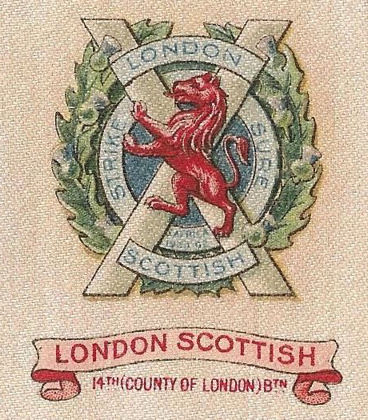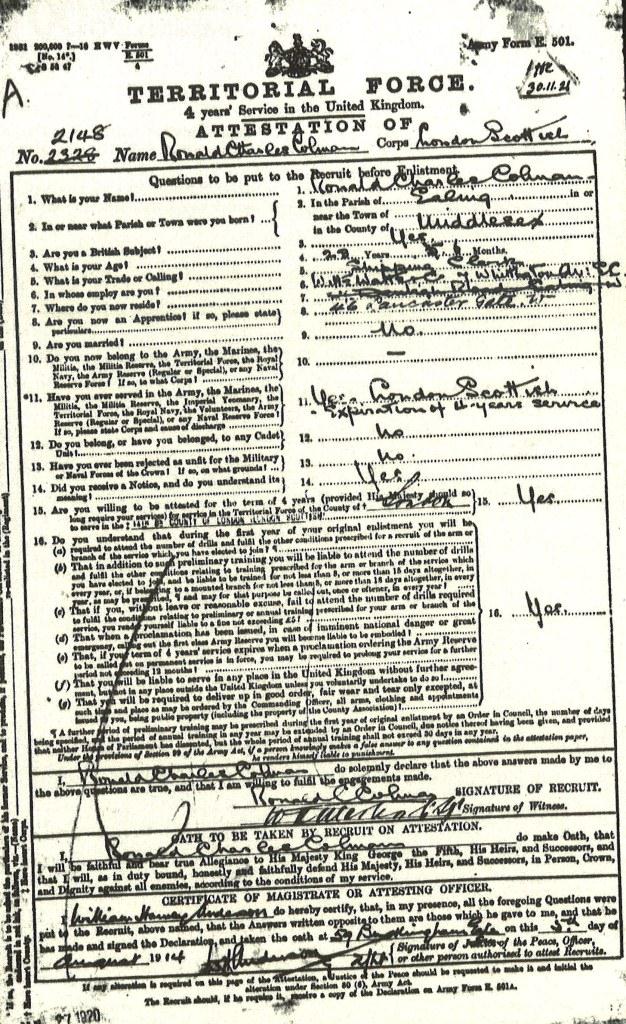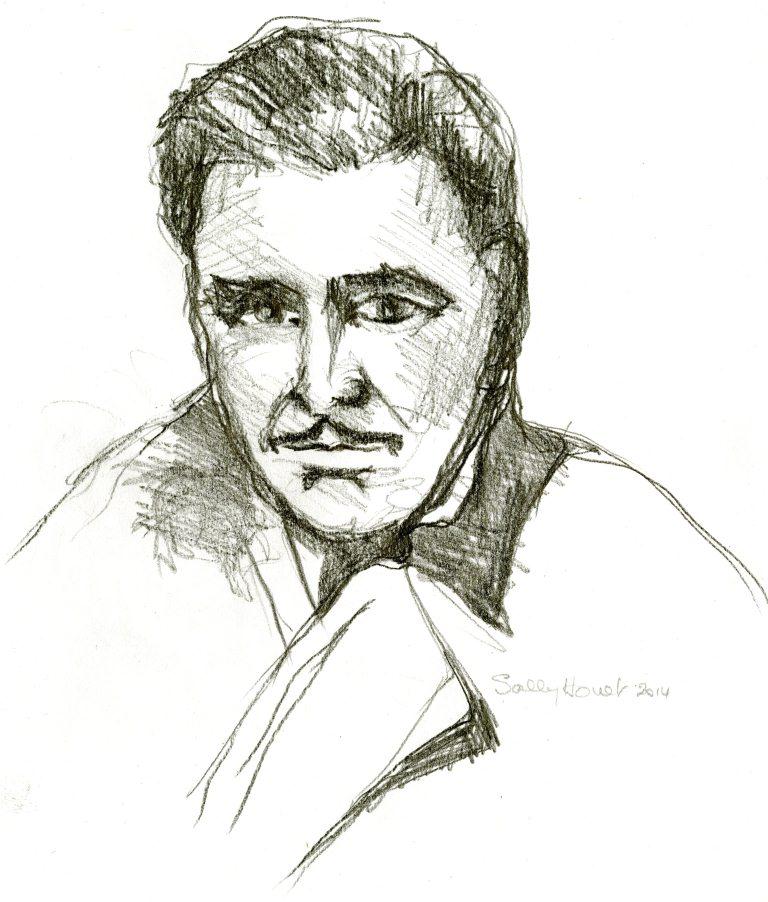
London Scottish silk badge, 1915. The badges were issued in cigarette packets. This one was issued by Godfrey Phillips Ltd in 1915 as part of the ‘British Army Light Infantry regiments’ series. Image courtesy of James Cronan.
It’s a line up that would make any film an instant Hollywood blockbuster. In the First World War four home-grown British actors, who would go on to grace stage and screen both in the UK and in America, enlisted in the 14th Battalion, London Regiment (also known as the 14th County of London Battalion and the London Scottish). Ronald Colman was the first to enlist, followed by Basil Rathbone, Claude Rains and Herbert Marshall. The simplest explanation for this is that the London Scottish had their regimental headquarters in the Horseferry Road in Westminster, central London. Their drill hall was at 56 Buckingham Gate, around the corner from Buckingham Palace, both within close proximity to London’s West End theatres.
During the course of the First World War, three line battalions of the London Scottish were formed. In September 1914 the 1/14th were sent to France. At Messines on 31 October 1914 the 1/14th became the first territorial infantry battalion to see action against the Germans.
The battalion served in France and Flanders throughout the war, taking part in every major offensive, including the battle of Loos (1915), the battle of the Somme (1916), the second battle of Arras (1917), the battle of Passchendaele (1917), the battle of Cambrai (1917) and the second battle of the Somme (1918). The war diary for the 1/14 London regiment covering 1 August 1914 to 21 January 1916 can be found in WO 95/1266/2 and for 1 February 1916 to 31 May 1919 in WO 95/2956/1.
The second line battalion, the 2/14th battalion, was raised in September 1914 and was posted overseas in June 1916, as part of the 60th Division. They saw action in France and Flanders, the Balkans, Salonika, Egypt and Palestine. In Palestine they assisted in the capture of Jerusalem before returning to France in July 1918.
The war diaries for the 2/14 battalion are found in WO 95/3030/4 from 1 January 1915 to 30 November 1916; WO 95/4928 from 1 December 1916 to 30 June 1917; WO 95/4668 from 1 July 1917 to 21 May 1918 and WO 95/2340/2 from 1 June 1918 to 31 August 1919.
A third line battalion, the 3/14th battalion, was formed in November 1914 and served at home as a reserve battalion, supplying troops to the two overseas battalions.
Ronald Charles Colman
Ronald Charles Colman (1891-1958) was an Oscar winning film actor, whose Hollywood career stretched from the 1920s to the 1950s.
Colman enlisted as a Private, number 2148, in the 14th Battalion, London Regiment, on 5 August 1914. His service record, WO 364/5113, is available to download on the subscription website Ancestry. Colman had previously served with the London Scottish from 1909 for a period for four years. Prior to his enlistment in 1914 he had been working as a shipping clerk and appearing in amateur dramatic productions on stage.

First page of the attestation form of Private Ronald Charles Colman, 1/14 London Regiment. Document reference WO 364/5113
Colman was wounded on 31 October 1914. The war diary for his unit can be downloaded for a small fee from Discovery, our catalogue, at WO 95/1266. At 8.30 am on 30 October his unit were ordered to attack a windmill outside Messines. The attack left 11 officers and over 250 men of other ranks killed or wounded. Colman’s service record reveals that his injury was diagnosed as a severely sprained ankle. He was shipped back to England on 1 November 1914. On his medical notes Colman stated that he was in action near Ypres when he was thrown into the air by an exploding shell and injured his ankle on landing.
He was discharged as no longer physically fit for war service on 6 May 1915. He was granted a Silver War Badge on 12 June 1917 (awarded for those discharged due to sickness or wounds caused by war service) and a mark of distinction to his 1914 Star campaign medal. He also received the Victory and British War campaign medals WO 372/217810.
Following his discharge from the Army, Colman obtained work in repertory theatre before moving to America and a career in Hollywood. During a long film career he won an Oscar for best actor for his part as Anthony John in the 1948 film A Double Life, and was nominated for three other Academy Awards for Bulldog Drummond (1929), Condemned (1930) and Random Harvest (1942). Ronald Charles Colman died in 1958 and is buried in Santa Barbara, California.
Philip St John Basil Rathbone
Philip St John Basil Rathbone, MC (1892-1967) was born in South Africa to British parents. His father Edgar, a mining engineer and mother Annie, a violinist, relocated to Britain in 1895. In the 1901 Census (RG 13) they can all be found, along with his younger siblings Beatrice and John, at 145 Goldhams Terrace, Hampstead. You can download census returns for a fee from our catalogue. Rathbone was educated at Repton School in Derbyshire. In the 1911 census (RG 14) he is listed as an insurance clerk, aged 18, born in Johannesburg, South Africa, but British subject by parentage.
On 13 November 1915 Rathbone enlisted in the 14th Battalion, London Regiment. His service papers are in WO 374/56295. Rathbone was aged 23 years 5 months and was living at 119 Delaware Mansions, Elgin Avenue, London. He gave his profession as ‘actor’ and his previous military experience as serving in the Officer Training Corps at Repton school. He was a tall, imposing man, standing at over 6 feet tall. His attestation form reveals that he married Ethel Marian Foreman in October 1914 and they had a son, Rodian Basil Rathbone, who was born in July 1915.
On 29 August 1916 Rathbone applied for a commission with the 10th Liverpool Regiment, a territorial force reserve battalion, which was authorised on 25 January 1917. His referee was Lionel Ford, headmaster of Harrow school and formerly of Repton school. In March 1917 Rathbone was diagnosed with measles but swiftly recovered.

First page of the attestation form of Private Basil Philip St. John Rathbone, 3/14 London Regiment. Document reference WO 374/56295
He served as an intelligence officer with the 10th Liverpools in France, attaining the rank of Captain. On 10 April 1918 he was recommended for the Military Cross for an action near Parvillers. The citation reads:
‘For conspicuous daring and resource on patrol. On one occasion, while inside the hostile wire, he came face to face with one of the enemy, whom he at once shot. This raised the alarm, and an intense fire was opened, but he crept through the entanglements with his three men and got safely back. The result of the patrolling was a through knowledge of the locality and strength of all enemy posts in the vicinity.’
After the war Rathbone joined the Royal Shakespeare Company, appearing in several of its productions, as well as other plays in London and Broadway. His film career began in 1925 and he appeared in over 70 films. He is best known for playing Sherlock Holmes alongside Nigel Bruce as Dr. Watson. In 1948 he won a Tony for Best Actor in a Broadway Performance for the role of Dr. Austin Sloper in The Heiress (1947). He has three stars on the Hollywood Walk of Fame, one for films, one for television and one for radio. Rathbone died in 1967 and is buried in Hartsdale, New York.
Watch out for the second part of this blog on the 14th Battalion, London Regiment, the London Scottish, featuring the service histories of Claude Rains and Herbert Marshall.



I never knew that. Brilliant!!
Nigel Bruce (aka Dr Watson with Basil Rathbone in his Sherlock Holmes films) has a file at TNA (WO 339/74044, William Nigel Ernle Watson), although he was born in California in 1895 and his birth was registered in Mexico. The file also includes injuries caused to him by a cricket bat in 1918. Nigel was a Private in 1914-1915 and got a Commission as a 2nd Lieutenant but due to injuries he got at Kemmel in Belgium in January 1915 he never took up the post but was in hospital having various operations arising from the injuries he received in Belgium.
Thank you David, that is very interesting. We did pick up on Nigel Bruce’s file when the WO 339s were being re-catalogued recently. That project has greatly improved access to the records and I will give it a good plug when the second part of this blog comes out next week, with the service records of Claude Rains and Herbert Marshall.
I think you are right, it would have made just as good a story to run a blog along the lines of Holmes and Watson served as officers in the First World War. Both Rathbone and Bruce clearly had very noteworthy war service.
We have identified plenty of famous officers within the records of WO 339 and WO 374 and some of these will be used to better publicise the cataloguing projects. As far as actors are concerned we also have the officers service records of Stanley Holloway, Cedric Hardwicke and Gordon Harker.
My family, were the McLaglen’s. Originally their name was MacLachlan but when they went to live in Cape Town South Africa from Scotland their name got changed by a Dutch clerk there. My grandfather who was born in Cape Town, (and so was his father) came back to the British Isles and landed in London to the poorest past and had ambitions to become a cleric. Within a short time he had met a lady and got married. The marriage produced 8 boys and a girl. They all possessed big personalities. Several of the boys copied their eldest brother and ran away to join the Army, when they were far too young. Victor joined the Life guards at 14 but eventually his father tracked him down and got him out. All the lads were in the First World War. My father, Clifford McLaglen who was eventually in the circus and Variety and on the stage on Broadway and a star in France and Germany in silent films, ( Cavalcanti’s “Yvette” & “Rien que les Heures” the latter can still be seen on You Tube, was the first out to France. Uncle Victor McLaglen,went to Trafalgar to get men to recruit. He had ambition s to become the World Heavyweight Champion of the boxing world, but ended up after making films in the UK, going to Hollywood and becomng a household name, and winning the Oscar for Best Actor for “The Informer” in the John Ford film of 1935. He was also nominated for Best Supporting Actor in “The Quiet Man”. His son was Second Assistant Director but ended up doing most of the filming for Ford.Only the last two boys served at cadets because they were too young. Cyril went to Hollywood and his expertise with horses helped him to be amongst the silent band up support actors. Arthur who was completely deaf still managed to help the war effort in both world wars with his artistry as he was a very good letterer and Sculptor. They were all actors of the silver screen, in silent films and some went on to do talkies. Lily helped with the war effort in Management and with the poor with her father under St Martins In the Field at many a Christmas.
The Second World War came and my Father joined up again. He went out with horses and ended up being an engineer in the army. He went with a group to guard Sir Winston Churchill when he went to Iceland. Leopold McLaglen managed to be in all the forces. His last stint was helping to look after Brize Norton in WWll. He was an actor with a speciality in horse riding and armed and unarmed combat as many of his brother were as well. He invented a version of Judo called Jiu Jitsu and taught it to school girls and boys and the armies of the British Empire as it was then all over the world. He even managed to teach his nephew, Andrew when he was a cadet at Harvard, ( who Directed “The Quiet Man”) some jiu Jitsu. Leo was a character and an adventurer. He had won many a bout of Judo and was a champion, and had warned the USA about the Japanese being a dangerous threat, but instead they felt that he was a threat, and ignored his revelations and threw him out. Lewis made films in the silent era and was also in the army and Kenneth also. Fred died of his wounds in the Great War, after working hard to become a world class boxer. He was loved by his brothers who took a page out of his book and all fought not only in bouts of Judo but, with epees, swords, guns and also unarmed in wrestling and boxing bouts. Both Fred and Victor took the name Fred McKay and managed to box the First Black Heavyweight Champion of the World, Jack Johnson. Victor was proud to have got into the ring with him and they both took part in a n Exhibition Fight when he was a famous Film Star. He was knocked out in the third round.
Thank you Cynthia for that fascinating posting. What an amazing family. We have Victor’s service record in WO 374/44874 http://discovery.nationalarchives.gov.uk/details/r/C715002
It is in the series that we are due to improve with full names and regiment.
Frederick’s papers are in WO 339/44618 http://discovery.nationalarchives.gov.uk/details/r/C1098508
It looks as if your father’s First World War papers and those of Lewis are still with the MOD as they reenlisted after the war.
We have the medal index cards for your father and for Arthur, Frederick, Lewis Sydney and Victor. They have been scanned and can be downloaded for a small fee at http://discovery.nationalarchives.gov.uk/results/r?_aq=Mclaglen&_cr1=wo%20372&_dss=range&_ro=any
The cards for your father and Arthur are together on one page and those for the other brothers on the other.
I think the British Film Institute would be very interested in your recollections, if you don’t mind me sharing your posting with them.
I will add the McLaglen’s to our list of famous soldiers from the first World War.
Many thanks, James
Dear Ms McLaglen.
I am researching the provision of jiu jitsu to British troops in the Great War and am particularly interested in Leopold McLaglen.
Please could you possibly contact me? I have supplied my email but you amy also contact me through the admin department of the institute:
http://www.instituteofmartialartsandsciences.com
Many thanks
Jaimie
Prof. J R Lee-Barron PhD
Dear James, Thanks for the appreciation. You can give permission for the BFI to use my notes. I have visited the BFI, off Tottenham Court Road, in London with my mother before she died and with my sister, and we watched, “The White Sheik”; “Ally Cat” OR “Nachtgeshtalten” which was a corr
Dear James ,
Yes you can give the BFI my recollections (above) with my permission. Clifford McLaglen was seen by his family at the BFI before his wife Kay died, and we watched, “Alleycat”, and “The White Sheik”. Cynthia McLaglen